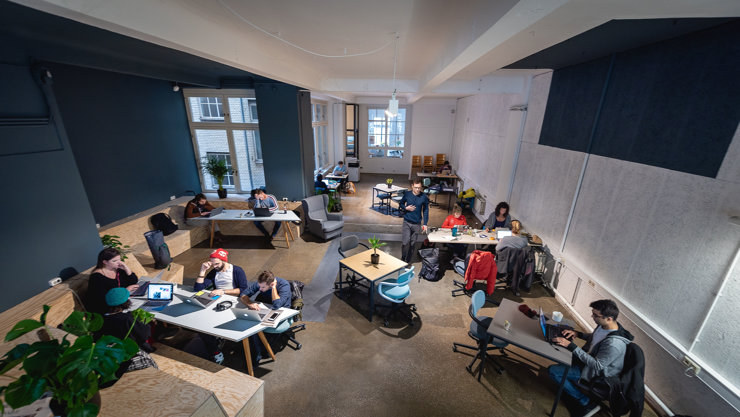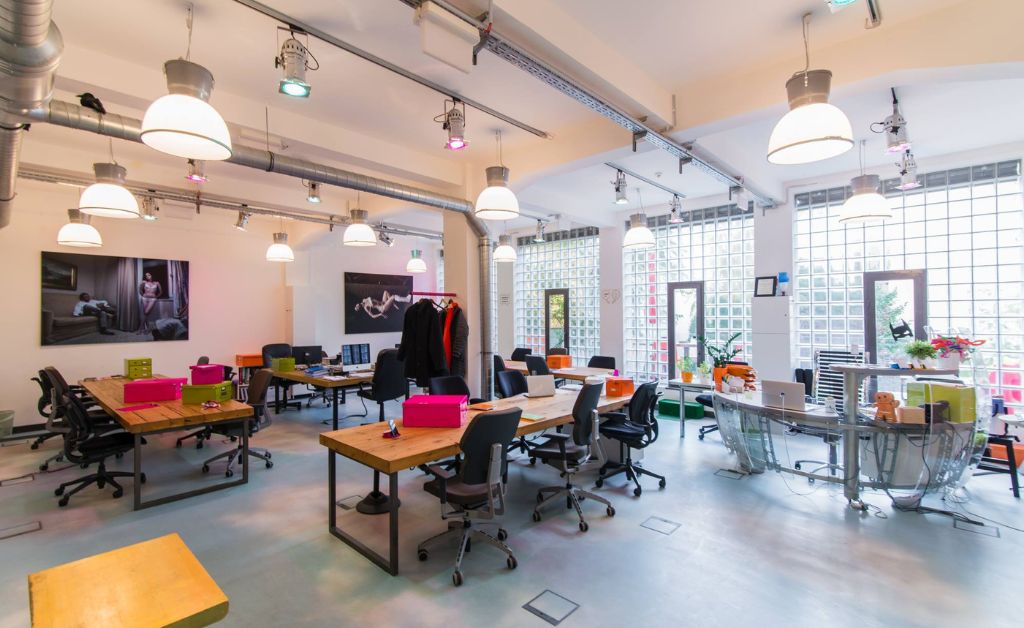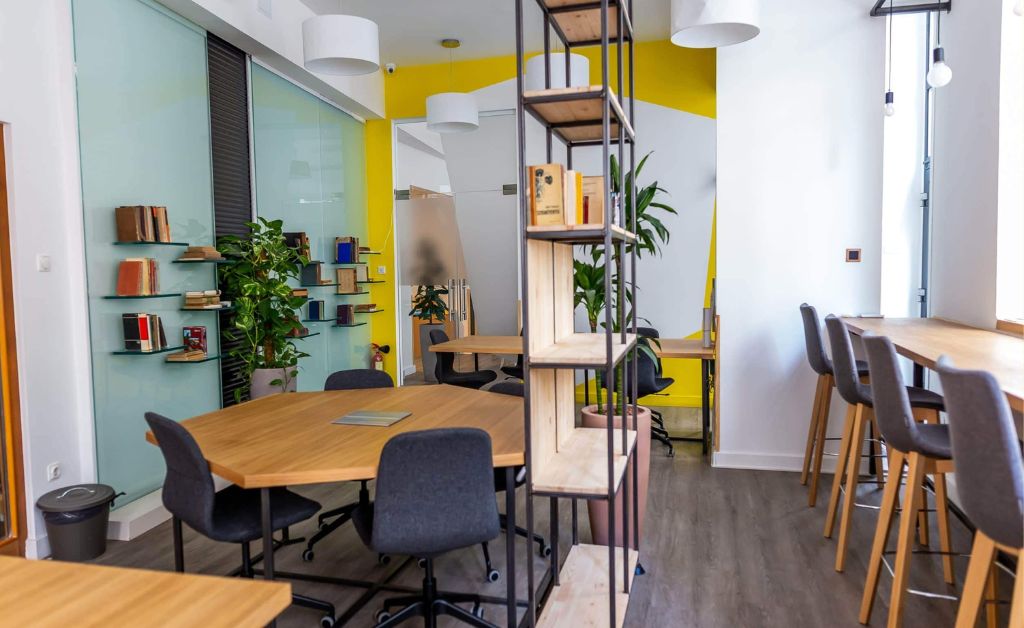ㅤ Coworking Spaces began to take shape in the late 1990s. This trend started simultaneously in various parts of the world and has now conquered the entire globe. Let's take a look at how this global movement began and the milestones that led to the widespread adoption of coworking spaces.
1995 – The first coworking space
One of the first places used as a coworking space was C-base, which opened in Berlin in 1995. The place became known as hackerspace because it was created by hackers with the goal of sharing space and knowledge and working together on coding projects. Following this, more and more hackerspaces (also known as hacklabs, hackspaces, or makerspaces) began to form, where people with similar interests, such as computers, technology, science, digital art, or electronic art, would meet, organize seminars, and host community events.

C-base developers meeting (source: Wikipedia)
1999 – The term "coworking" was coined
Bernard DeKoven coined the term "coworking" in 1999, which referred to collaboration between equals. Initially, "coworking" didn't necessarily pertain to dedicated workspaces but focused more on collaboration and community networks.
In the same year, two coworking spaces opened in New York City where users could rent workstations. 116 West Houston (later known as Nutopia) operated as a work club without walls and booths. Similarly, 42 West 24 also thrived, with a total of 50 coworkers utilizing the space.
2002 – The Schraubenfabrik entrepreneurial center opens
In 2002, two Austrian entrepreneurs established the Schraubenfabrik entrepreneurial center in an old factory building. The space became a community hub for various professionals, including PR consultants, startups, and freelancers. Later, under the aegis of Konnex Communities, the initiative expanded with two more locations: Hutfabrik (Hat Factory) in 2004 and Rochuspark in 2007. These new spaces quickly gained popularity among local freelancers.
2005 – The first official coworking space opens
Most people mark 2005 as the beginning of the coworking movement, as this was when the first official coworking space opened its doors in San Francisco. Named the "Hat Factory," this space was founded by Brad Neuberg, who aimed to create an environment that combined the comfort of working from home with the community aspects of traditional offices. The space provided a shared working environment for technology and creative professionals.
2007 – The establishment of "coworking"
In 2007, the term "coworking" first appeared in Google search results and quickly became a widely searched term. That same year, the term "coworking" was also included in a Wikipedia article.
Due to the growing demand for coworking spaces, by the end of 2008, there were approximately 160 coworking spaces operating worldwide. The rapid growth continued, with more coworking spaces opening in various countries.
2009 – Betahaus opens
In 2009, Betahaus opened in Germany,, which was then the largest coworking space in Europe and continues to operate today. Germany played a leading role in the development of coworking in Europe.

Betahaus, Berlin
2010 – Coworking Day and Coworking Conference
In 2010, the first #CoworkingDay was celebrated (although there had been an attempt five years earlier). That same year, the first European coworking conference was held in Brussels.
In 2010, WeWork was founded by Adam Neumann and Miguel McKelvey.
While WeWork is not a traditional coworking space, it is indirectly related to coworking as it offers an alternative office rental service, providing businesses and freelancers with the opportunity to rent workspace on a short or long-term basis. WeWork is noteworthy for its rapid and dynamic growth, becoming one of the world's most valuable technology companies by 2017. However, after a failed IPO and the controversial departure of Adam Neumann in 2019, the company's value drastically decreased. Despite filing for bankruptcy in 2023, WeWork continues to operate in many locations worldwide.
Coworking spaces in Hungary
In Hungary, the first coworking spaces began to appear around the 2010s. Loffice and Kaptár were the pioneers, followed by numerous other offices in Budapest. The local coworking landscape has become increasingly diverse in size, style, and location. In recent years, coworking services have also become more accessible in various rural areas.

Loffice Coworking Office (2015 image from Loffice's Facebook page)

Kaptár Coworking Space
Nowadays, coworking spaces can be found even in small villages and county seats, where freelancers and entrepreneurs work alongside employees who operate from home offices. Over time, the home office can become monotonous, so stepping out into a different environment for a day or two provides a refreshing change.
2012 – The number of coworkers surpassed 100,000
By 2012, more than 100,000 people worldwide were using coworking spaces, with the number of such spaces reaching 3,000.
2015 – Digital nomads discover coworking
In 2015, the New York Times wrote about a new trend where coworking and travel became closely intertwined. The article, titledCo-Working on Vacation: A Desk in Paradisehighlighted how the "workation" trend became popular primarily among digital nomads. These individuals could work from anywhere in the world and often used coworking spaces while traveling.

Digital nomads only need a laptop to work
Starting in 2016, more large corporations, including major names like Microsoft and IBM, began relocating their employees to coworking spaces, recognizing their flexibility and benefits..
2021 – COVID challenges and further growth
Despite the challenges posed by COVID-19, the coworking industry demonstrated resilient growth and even showed a strengthening trend post-pandemic. The job market increasingly shifted towards more flexible, decentralized work environments. By 2022, the number of coworking spaces worldwide was estimated to be around 19,400, and according to the statistics below, nearly 5 million users are expected to benefit from coworking spaces by the end of 2024.

Illustrating the growth in the number of coworking space users over the years (source: Zippia.com)
Source Deskmag.com, Zippia.com




